The unity and divide between man and nature is and has long been a prevailing theme of many artists and curators. Open Field at Tiger Strikes Asteroid (TSA) draws on the functions, failures, and artifices created between nature and culture to explore aspects of the great man/nature divide.
The nine artists in the show, curated by artist, educator, and TSA member Andrea Gaydos Landau, work in various media, from painting to fibers to sculpture. Most of the works are medium-sized, with the exception of a large painting by Rebecca Saylor Sack.
Works that naturally belong
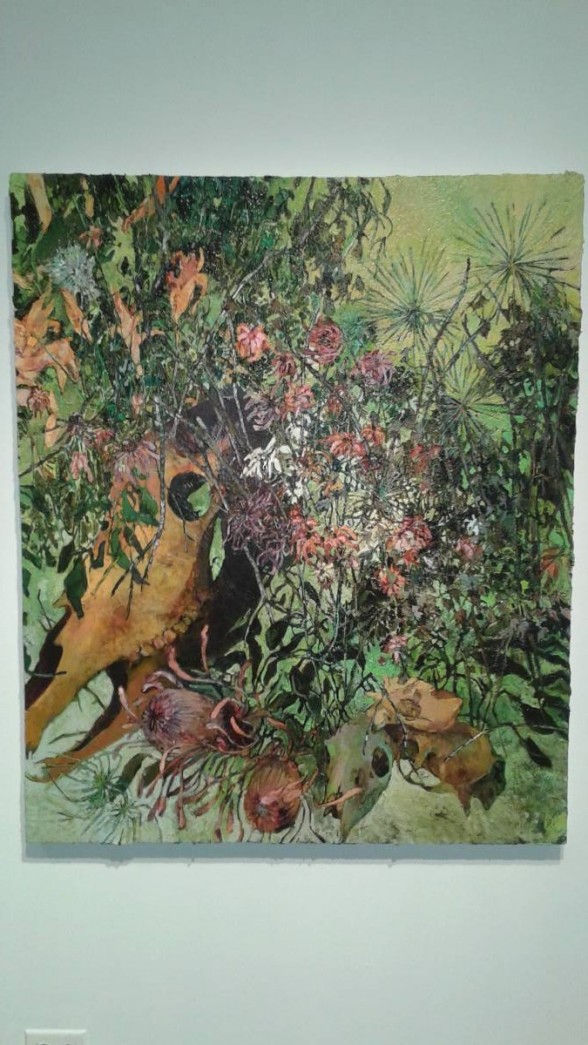
Saylor Sack’s provocative painting “Untitled (deer, horse)” portrays the bones of a deer head and a horse head among a bed of blossoming flowers. We have to suspect that these two animals died naturally and not by man. The thick impasto surface gives the painting an appropriately earthy texture that mimics and makes palpable the feel of the individual flower petals and the roughness of green leaves and stems. Saylor Sack focuses on the most primitive elements of nature–growth and decay– amid a changing environment. This is heightened by the artist’s rich palette of warm and cool colors.
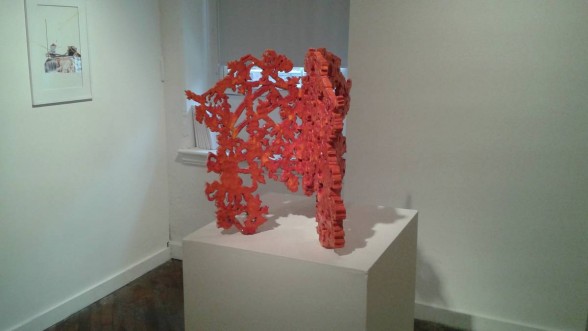
Andrea Marquis’ “Coeur” also mimics the natural world, in a hand-carved stoneware clay sculpture glazed in radiant red-orange pigments, whose title is the French word for “heart”. The shimmering surface combined with the ornately symmetrical composition evokes an ethereal, even harmonious quality–the sculpture appears to be the remnants of hardened volcanic lava. The piece may possibly suggest sea coral, an ecosystem for marine life, and parallels to humans living in dynamic shared communities.
Suggestions of damage and obscuration
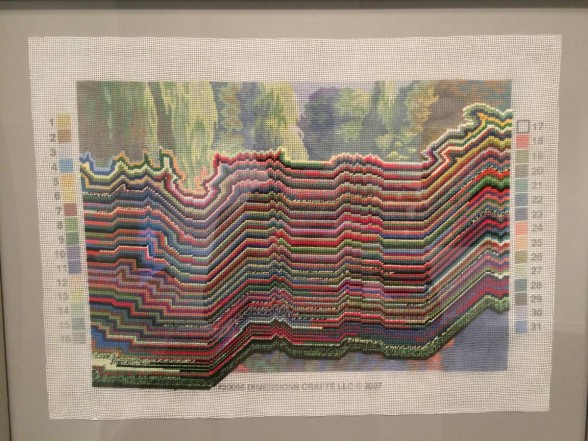
But art can be more than mimicry, and conceptual art like Mary Smull’s “Woods” takes the discussion into far different realms. Smull, a fiber artist who juxtaposes the organic and the manmade, stitches various light- and dark-colored yarns horizontally on a store-bought needlepoint cloth, partly obliterating the printed landscape underneath. Smull is literally stitching by numbers, 31 color options total. Using a systematic approach of color coordination, Smull sews together an original abstract landscape filled with striking lines and unusual colors. The artist, similar to 19th-century landscape artists, seeks to create an idealized, sublime landscape. However, Smull’s abstraction raises the point that such heavenly scenes are a thing of the past, if they ever truly existed, especially after the onset of industrialization.
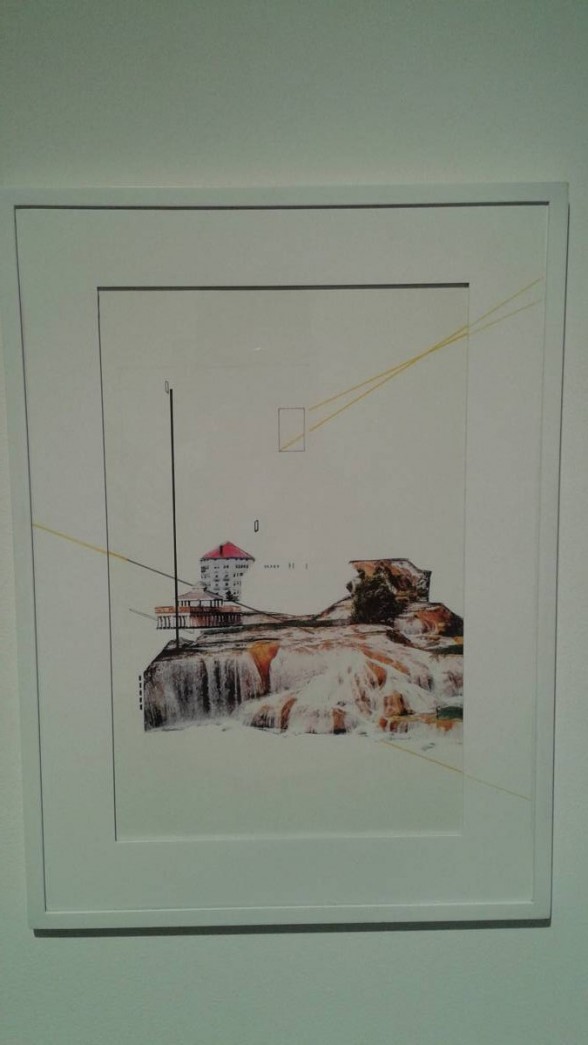
Dealing in perhaps the most direct way with contemporary mankind’s impact on the landscape, Lauren Sauder’s mixed-media “The Edge of the Water” shows a luxury resort nestled beside the river, as if portrayed in an architect or developer’s plans. On the print’s surface are several intersecting black and yellow vertical and diagonal lines drawn in pen or colored pencil. The print resembles an architectural blueprint with notes pinpointing new areas of construction or future modifications. The artist has chosen to clip certain images and physically alter the landscape. We are now viewing a piece from the editing process. What remains? What must go? These questions arise as contractors, engineers, and architects prioritize their social responsibilities, but at what cost?
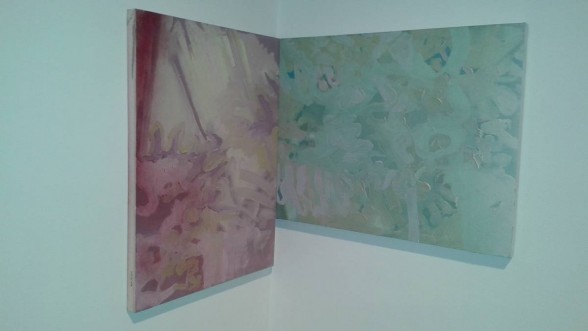
The broad, expressionistic strokes of rapid, continuing motion in Anthony Bowers’s 2-panel abstract painting hint at the equilibrium possible when two unequal worlds collide. “The world moves faster than you do 4, 5” recalls Saylor Sack’s contrasting use of warm and cool colors. However, Bowers depicts no figuration. Building a balance, as Bowers has painted, suggests a unification between people and possibly (in the context of the show) between people and nature.
Also in the show are Kate Abercrombie, Shelby Donnelly, Chris Landau, and Kate Stewart.
While Open Field features some pieces worthy of discussion, as a collective whole, the exhibition falls short on an age-old theme. The issue of man (culture, the built environment) and nature is nothing new. I understand that some of the artists perceive this theme as more than a “simple binary answer,” as stated in the show’s press release. It seems to me that the works in Open Field have been gathered together under a thematic conceit that might not be true to the pieces themselves. Also, some of the smaller works do not visually pair well with the stronger pieces, making for an uneven viewing experience.
Earlier this summer, I wrote about another exhibit, The Usable Earth at Esther Klein Gallery in the University City Science Center, which, like Open Field, examined the conflicting relationship between man and the environment. That show more successfully conveyed socio-ecological problems, with works that clearly referenced the effects of man’s presence on untouched land. For TSA, Open Field could have been an opportunity to present something new to the field and maybe spark different conversations.
Exhibit curator Andrea Gaydos Landau and writer Jesse Smith will host a participatory event at the closing reception on Saturday, August 29 at 4 pm.
Open Field is on view through August 30, 2015 at Tiger Strikes Asteroid.









